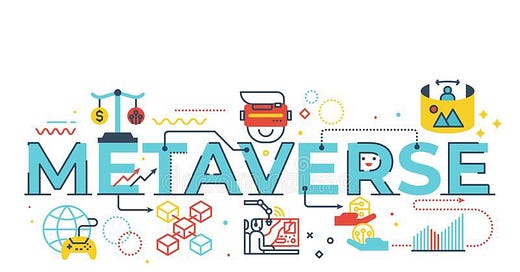Designing for the Metaverse: 3 strategic pillars of success
The success of the metaverse lies on 3 things: enterprise-first, a strong dev ecosystem and platform creation.
I’ve tried to avoid thinking or writing about the metaverse for as long as I could, but I can’t dance around the elephant in the room anymore. Billions of dollars are already being invested into the metaverse, from the infrastructure layer all the way out to the experience layer in its value chain¹. With so much capital influx, how do we avoid a repeat of the 2000 dot com burst and avoid becoming Pets.com 2.0²? I believe that the success of the metaverse lies on three main strategic pillars:
Enterprise adoption
Building a strong developer ecosystem
Platform creation >> Platform attraction
The Multiverse?
The metaverse is in its essence, a digital marketplace ecosystem. I believe that there will be multiple metaverses, that will use the Internet as an interoperability layer to create the multiverse. That is, all apps, services, products, users and transactions from each individual metaverse will be able to “talk” to each other and share data across their virtual borders, analogous to the mobile super-apps that exist today.
Pillar One: Enterprise Adoption First
My first hypothesis for the success of the multiverse: It will have to prove itself in the enterprise segment before it can reach critical adoption by consumers globally.
Remote work is here to stay
The pandemic has accelerated our shift towards a hybrid mobile workforce. At the beginning of the pandemic, many tech companies started offering fully-remote work options and then traditional employers like banks started following suit³. Workers are loving this shift too, where 2/3 of the people surveyed by the World Economic Forum said they prefer a “flexible working” option⁴.
While working remote has its benefits, there are a couple of limitations with its work culture:
The lack of liminal spaces — Innovation and creativity often happen organically. Like when two colleagues bump into each other in the office kitchen or hallway and start sharing ideas. The lack of physical proximity can stifle innovation, creativity and collboration within a company
Remote employees can be overlooked in their career⁵ — The BBC wrote a great piece on how remote workers’ career growth can be stunted, simply because they have less face time with their peers and leaders. As the saying goes: “Out of sight, out of mind”
These are real problems in the workforce today that companies are looking to solve with big investments — Accenture ordered 60,000 Oculus headsets for its employees.
Enterprises have the risk appetite and the willingness to invest in these types of new technologies as they try to chase productivity and embrace the shift to a distributed workforce. The cherry on top? Once users have interacted with the metaverse at work, they might better understand its value proposition and consider adopting it for personal use at home.
Pillar Two: A Strong Developer Ecosystem
My second hypothesis for the success of the multiverse: A strong developer ecosystem is critical to building supply-side capacity in the marketplace.
At its core, the metaverse is a marketplace experience. The success of any digital marketplace product hinges on its ability to generate user demand while bolstering supply-side capacity (eg. Uber having enough drivers to meet rider demand). The metaverse is not exempt from this chicken-and-egg rule. This ties back to pillar one, when the ability to perform your job depends on your interaction with the metaverse (ie. your company says you have to use tool X), it creates user demand which in turn incentivizes developers to build things for those users.
On the supply-side, no single company will ever be physically capable of building the apps and/or experiences within each metaverse to attract critical mass. This is why the metaverse platform with the best developer experience, developer tools and incentive system will attract the brightest minds and become host to the most engaging VR apps and experiences. Today’s analog to this would be the Apple App Store or the Play Store.
Pillar Three: Platform Creation, not Platform attraction
My third hypothesis for the success of the multiverse: Focus needs to be on platform creation, not platform attraction.
What the heck does that mean? Platform attraction is the idea whereby users and developers flock to a platform like the Apple app store because of its massive distribution power driven by iPhone and iPad sales. The value of the platform is derived by external factors like the beautifully designed Apple hardware or ecosystem lock-in. Platform creation, however, abstracts away from any one type of device, OS or ecosystem. It focuses on building a device agnostic software platform that can run the metaverse suite of apps, products and services.
A perfect example of platform creation is Microsoft’s Power Platform. Microsoft lost the mobile OS wars to Android and iOS. They were forced to abstract away from hardware and build a device agnostic cloud platform like O365 and Teams. Microsoft Teams is very well-poised to adapt to the notion of a metaverse where the hardware is secondary, but the software ecosystem that runs it will be imperative.
Who can build the best metaverse?
In my opinion, the contenders are Microsoft, Google, Meta and Apple, but Microsoft comes out on top. This is because of their heavy focus on enterprise with Azure, Teams and O365. They’ve also built out a solid developer tools strategy with Github, VSCode and direct deployment to Azure. Microsoft has done a stellar job to build a self-reinforcing feedback loop with their dev tools, Azure and Teams:
Build software for Teams or the Power platform using VSCode and Github → Deploy to Azure easily → Increase engagement and dependency on Teams → Make more money from Azure consumption and Teams licenses.
They’re firing strong on all the three pillars above.
If you want to understand how I evaluated Google, Meta and Apple, refer to my analysis in the table below.
References
1: https://medium.com/building-the-metaverse/the-metaverse-value-chain-afcf9e09e3a7
2: https://www.investopedia.com/ask/answers/08/dotcom-pets-dot-com.asp
4: https://www.weforum.org/agenda/2021/07/back-to-office-or-work-from-home-survey/




